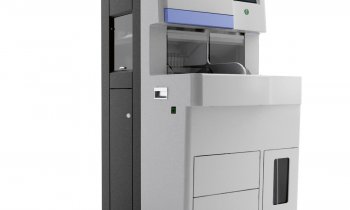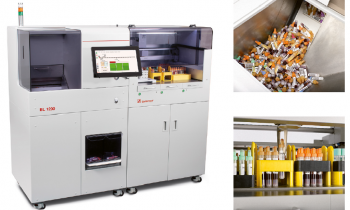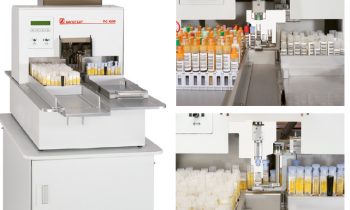Upgrading ‘Big Iron’ for the digital century
John Brosky reports
Switzerland - It is a classic problem in any business. Everyone is working so hard to keep up with the rapid pace of orders that no one has time to get ahead. For the clinical laboratory the problem has grown greater each year, to the point that today’s new high-throughput instruments are still shackled to slow-throughput wires.

Vital patient information from blood work-ups and molecular diagnostics is running through old 9 pin cables that are becoming harder to find on the back of computers. Some instruments are running at the extremely low-bandwidth rate of 9600 baud, for those who remember what a ‘baud’ is.
Rob Bush, at Orchard Software, knows this technology from the last century only too well. ‘With the volume of information moving on high volume analysers, this port has become a bottle neck,’ he said. In the best cases, instruments currently are connected to reporting software with two cables, one for input, the other for output, which he said is a work-around solution, like putting a plaster on a problem.
The risk for each of the major manufacturers of what is affectionately called ‘Big Iron’ instruments is to develop a solution to the problem that leads to a dead end. In other words, a smart answer that no one is ready to adopt. Rather than competing with each other, these companies agreed to form the IVD Industry Connectivity Consortium (IICC). The impressive membership includes top makers of clinical instruments such as Abbott Diagnostics, Beckman Coulter, Becton Dickinson, bioMérieux, Data Innovations, Orchard Software, Ortho Clinical Diagnostics, Roche Diagnostics, Siemens Healthcare Diagnostics, and Systelab Technologies.
The Chief Technology Officer for the IICC consortium, ED Heiermann, who is Vice President for Informatics & eBusiness for the Diagnostics Division of Siemens Healthcare, explained that the goal is plug and play, moving from the slow pin-cable serial port to a high-speed TCP/IP interface.‘We are building a better pipeline connection between laboratory information systems (LIS) and the lab analysers,’ he said.
The partners agreed to use an open and collaborative process for developing a new technology for clinical instruments through Integrating the Healthcare Enterprise (IHE), the joint initiative of healthcare professionals and industry dedicated to improve the interoperability of health information systems (HIT). According to Ed Heierman, ‘Of all the groups IICC has worked with, IHE provides a better place for us to work than any other organisation, creating the most opportunities to test and validate our solution while making a space for the engineers to interact.’
Writing a new LAW
The IICC-IHE work teams moved quickly to create a system integration profile named Lab Analytical Workflow (LAW). This reduces complexity and variability in the exchange of information related to patient and quality control test orders. The kick-off meeting was held in September 2010. Eighteen months later, the partners were ready to see if it would work – live and in real time. In May this year, six of the companies sent technical teams to Bern, Switzerland for the IHE European Connectathon, the connectivity marathon where, for five days, 350 software engineers validate that their new systems will work with any other HIT system. By the fourth day, Ed Heierman was smiling broadly, reporting that the performance was ‘flawless for this first effort using the draft supplement for trial implementation,’ in the language of IHE.
The next step, he said, is to prove out LAW at the next Connectathon, set for October in Tokyo. ‘Then we’ll go to Chicago in January where we hope to implement and use this specification with companies that have not been able to join us in Europe or Japan.’ In his day job, Ed Heierman is the Informatics Software Architect for Abbott Diagnostics. LAW, he said, will help the company’s customers make it easier to install the new generation of high-speed analysers. Before the new LAW, each company has a connection interface with reporting systems that is unlike anyone else’s, he said, and the challenge for a customer becomes the amount of time required and the effort spent to connect a new instrument.
Game changer for software developers
Rob Bush travelled from Indianapolis to Bern to test his company’s system at the first-ever trial of LAW, which he sees as a welcome development. ‘We have 1,200 labs using our software with interfaces for roughly 350 different Big Iron analysers form Abbott, Roche, Siemens, Biomérieux, Beckman Coulter and others,’ he said. ‘None of them use the same interface.’ The issue to be overcome, he explained, ‘is this critical connection between IVD instruments and the lab information systems (LIS) or any software the instruments needs to speak to, such as systems used to report results for clinical trials. An unknown for future development is how faster communication speeds on Big Iron may impact on the software packages that to this point have done the work of enriching patient specimen analysis with data linked to the patient, a well as physician and facility information. It could change the game, Rob Bush said, with the migration of this capability to the instrument performing the analysis. ‘Managing more complex patient information in a single system will create more efficient and effective reporting of results.’
10.07.2012











